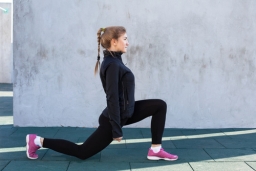Static vs Dynamic Stretching
Wednesday, May 3, 2017 - 09:24

Warming up is essential for athletic performance, not only does it get the body ready to train or compete, it can improve performance and help prevent injury as well. And one of the essential parts of the warmup is stretching those muscles out. However, there has been a long time debate going on over the concept of stretching’s role in performance. Which is better static or dynamic stretching? Well the answer might not be as simple as it seems and it may not be a case of one versus the other but a proper combination of the two working together as part of regular warmup/cool down program to help reduce injuries and boost flexibility.
Static stretching – involves stretching your muscle to the point where you feel tension in your muscle and perhaps a slight discomfort but no pain. The stretch should then be held with no movement for 15-30 seconds and repeated 3-5 times.
Dynamic stretching – involves controlled movements that relate to the movements of the sport/activity you are about to perform. These movements should be slow and take you through a full range of motion.
Benefits of dynamic stretching:
- Keeps the body continuously moving – Because dynamic stretching uses natural movement to engage muscles, your muscles’ core temperature is also increasing. And since the goal of a warm up is as it implies, to warm up the muscle prior to exertion, you’ve met that goal. Static stretching may in fact cool down the muscles through its lack of movement.
- Prepares your muscles through sport-specific movement – By using movements that are similar to those that will be used in your activity, not only are you warming up your whole body, you are preparing it for the specific activity to come.
- Warms up the mind – Whereas static stretching tends to relax the mind, dynamic stretching requires your brain to engage in the body’s movement, getting it ready to get involved in the exercise to come as well. It helps the mind prepare to support those sport-specific movements.
- Helps improve the range of motion around the joints – At the same time as you are warming up those muscles, dynamic movement works on the flexibility of your joints as well. Over time this will show in improvements to your movement and to your performance and help reduce risk of injury.
Benefits of static stretching
- Lengthens muscles and improves flexibility – When done after a dynamic warm up, static stretching can elongate muscles (especially if performed consistently over time. And knowing that research indicates performing static stretching close to performance time can reduce strength, make sure that you time your static stretches enough in advance to avoid this possible outcome.
- Improves range of motion – As in the above description, if you’ve warmed up your muscles and joints through dynamic stretches, incorporating some static stretches can also help increase your range of motion.
- Help reduce muscle tension and soreness – Performed as part of a cool down, static stretching can elongate the muscles and help increase blood circulation thereby helping to prevent post-exercise muscle pain.
- Relieves stress – As part of the cool down, stretching can be used to not only relieve the stress on muscle used in training and competition, it can help relax the mind.
When should you use each of these types of stretches?
The types of stretches you do and the timing of them can impact your athletic performance. Since dynamic stretches mimic movements about to be performed, doing them before a workout prepares those muscles you plan to use. And as outlined above, when used as part of the warm up, it warms muscle temperature, increases joint range of motion and gets your mind engaged.
You should only perform static stretches after your body is fully warmed up. Stretching cold muscle increases the risk of injury. Recommendations suggest that while you can do these types of stretches as part of an extended warm up, they are largely recommended as part of the cool down since static stretching immediately pre-exercise can reduce power and strength. Since static stretching uses no movement, post-exercise is great time to focus on relaxation and keeping the blood flowing to inactive muscles to help reduce soreness.
Different sports may require more or less focus on stretching depending on the desired outcome of the exercise. Some sports like gymnastics and diving use stretching not only to warm up the muscle, but require it in order to increase flexibility. But in general, using a combination of both dynamic and static stretching will help an athlete improve their performance and reduce risk of injury.
Sources:
Bible, A. (2016). Challenge the "Static" Quo. Men's Fitness, 32(2), 15.
Fardy, S. (2014). The Benefits of Dynamic Stretching vs. Static Stretching. Bodyscapes Fitness.
Gill, A. H. (2016). Stretching the Truth: A Review of Literature on the Effects of Static and Dynamic Howard, M. (2011). What is the major difference between static & dynamic stretching? Livestrong.com.
Stretching Protocols on Strength and Power Performance. Journal of Australian Strength & Conditioning, 24(7), 61-67.